Health Policy Analysis: Diabetes, Determinants, and Policy Advocacy
VerifiedAdded on 2022/09/25
|15
|4671
|21
Report
AI Summary
This report analyzes the health policy surrounding diabetes in the United States, a major non-communicable disease. It begins by defining diabetes, outlining its determinants (including social, environmental, and genetic factors), and highlighting its prevalence and economic burden. The report then examines the current government response, primarily the Diabetes Prevention Program (DPP), and identifies gaps in its effectiveness. The core of the report proposes alternative and complementary policy actions, advocating for community-based prevention programs that address the disease at the grassroots level, focusing on education, lifestyle changes, and data-driven targeted interventions. It also maps key actors involved in policy change, including government entities, healthcare providers, and advocacy groups, and analyzes their power using the power cube framework to assess their influence on policy implementation. The report emphasizes the importance of early intervention, particularly for children and adolescents, and highlights the need for a multi-faceted approach to effectively combat the growing diabetes epidemic.
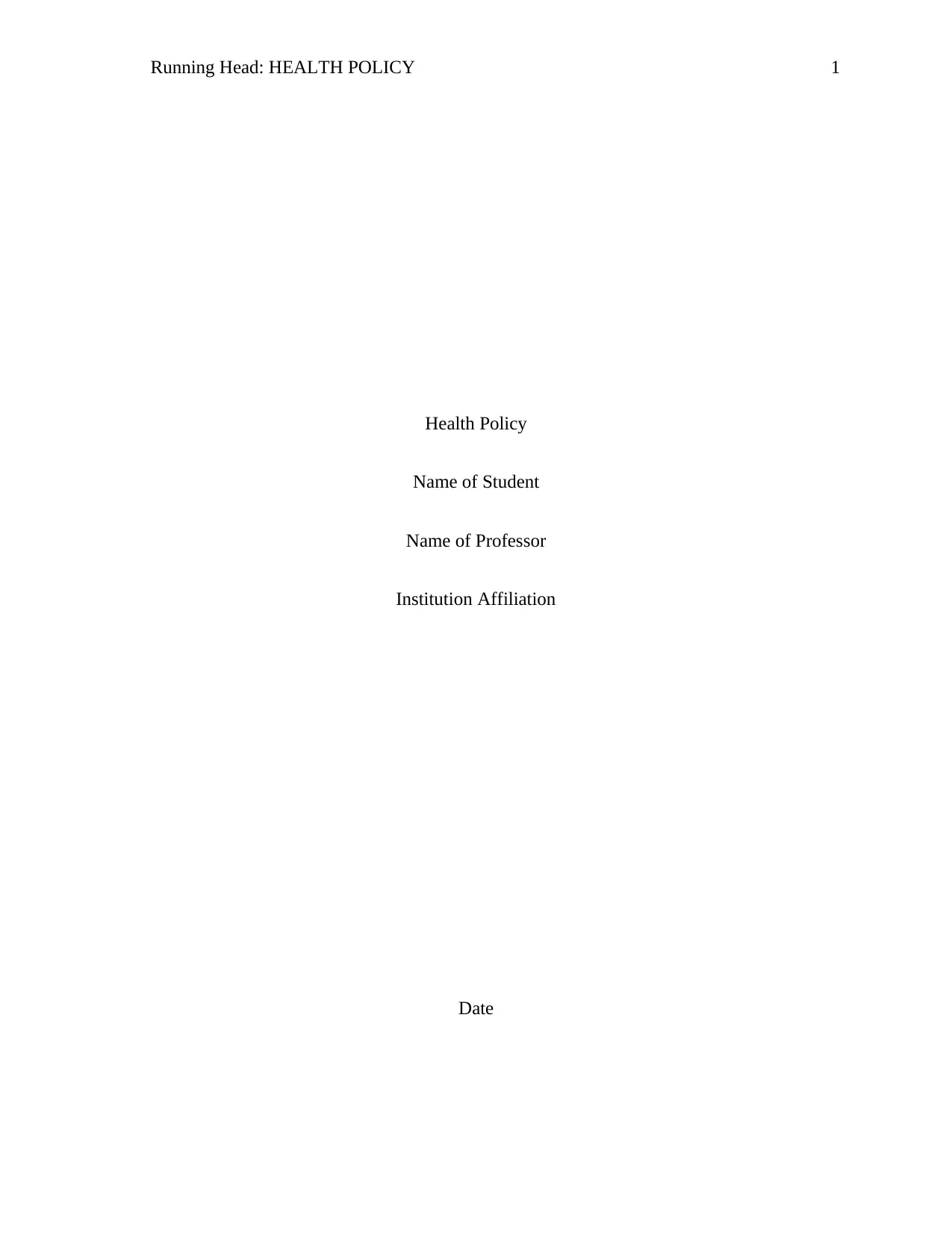
Running Head: HEALTH POLICY 1
Health Policy
Name of Student
Name of Professor
Institution Affiliation
Date
Health Policy
Name of Student
Name of Professor
Institution Affiliation
Date
Paraphrase This Document
Need a fresh take? Get an instant paraphrase of this document with our AI Paraphraser
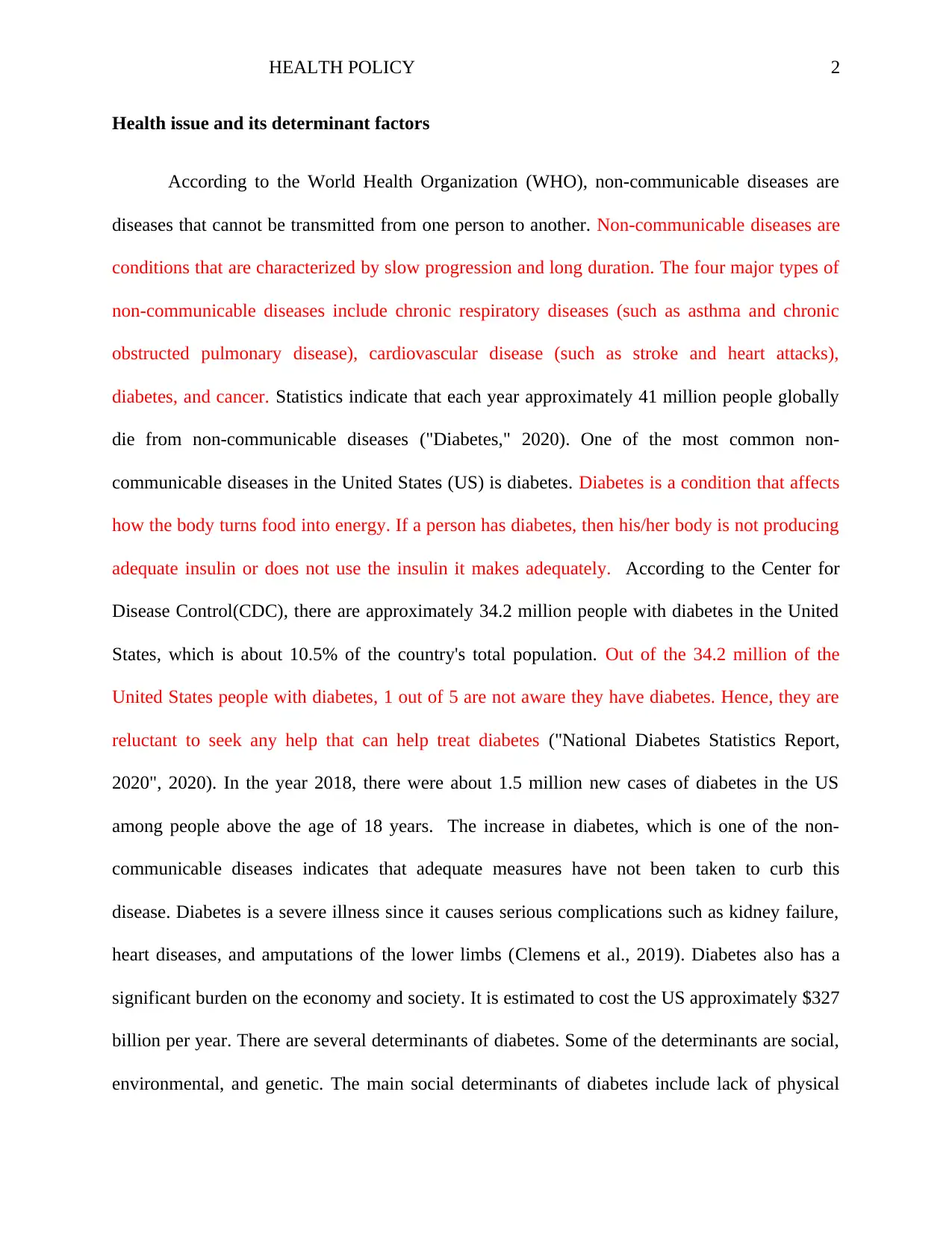
HEALTH POLICY 2
Health issue and its determinant factors
According to the World Health Organization (WHO), non-communicable diseases are
diseases that cannot be transmitted from one person to another. Non-communicable diseases are
conditions that are characterized by slow progression and long duration. The four major types of
non-communicable diseases include chronic respiratory diseases (such as asthma and chronic
obstructed pulmonary disease), cardiovascular disease (such as stroke and heart attacks),
diabetes, and cancer. Statistics indicate that each year approximately 41 million people globally
die from non-communicable diseases ("Diabetes," 2020). One of the most common non-
communicable diseases in the United States (US) is diabetes. Diabetes is a condition that affects
how the body turns food into energy. If a person has diabetes, then his/her body is not producing
adequate insulin or does not use the insulin it makes adequately. According to the Center for
Disease Control(CDC), there are approximately 34.2 million people with diabetes in the United
States, which is about 10.5% of the country's total population. Out of the 34.2 million of the
United States people with diabetes, 1 out of 5 are not aware they have diabetes. Hence, they are
reluctant to seek any help that can help treat diabetes ("National Diabetes Statistics Report,
2020", 2020). In the year 2018, there were about 1.5 million new cases of diabetes in the US
among people above the age of 18 years. The increase in diabetes, which is one of the non-
communicable diseases indicates that adequate measures have not been taken to curb this
disease. Diabetes is a severe illness since it causes serious complications such as kidney failure,
heart diseases, and amputations of the lower limbs (Clemens et al., 2019). Diabetes also has a
significant burden on the economy and society. It is estimated to cost the US approximately $327
billion per year. There are several determinants of diabetes. Some of the determinants are social,
environmental, and genetic. The main social determinants of diabetes include lack of physical
Health issue and its determinant factors
According to the World Health Organization (WHO), non-communicable diseases are
diseases that cannot be transmitted from one person to another. Non-communicable diseases are
conditions that are characterized by slow progression and long duration. The four major types of
non-communicable diseases include chronic respiratory diseases (such as asthma and chronic
obstructed pulmonary disease), cardiovascular disease (such as stroke and heart attacks),
diabetes, and cancer. Statistics indicate that each year approximately 41 million people globally
die from non-communicable diseases ("Diabetes," 2020). One of the most common non-
communicable diseases in the United States (US) is diabetes. Diabetes is a condition that affects
how the body turns food into energy. If a person has diabetes, then his/her body is not producing
adequate insulin or does not use the insulin it makes adequately. According to the Center for
Disease Control(CDC), there are approximately 34.2 million people with diabetes in the United
States, which is about 10.5% of the country's total population. Out of the 34.2 million of the
United States people with diabetes, 1 out of 5 are not aware they have diabetes. Hence, they are
reluctant to seek any help that can help treat diabetes ("National Diabetes Statistics Report,
2020", 2020). In the year 2018, there were about 1.5 million new cases of diabetes in the US
among people above the age of 18 years. The increase in diabetes, which is one of the non-
communicable diseases indicates that adequate measures have not been taken to curb this
disease. Diabetes is a severe illness since it causes serious complications such as kidney failure,
heart diseases, and amputations of the lower limbs (Clemens et al., 2019). Diabetes also has a
significant burden on the economy and society. It is estimated to cost the US approximately $327
billion per year. There are several determinants of diabetes. Some of the determinants are social,
environmental, and genetic. The main social determinants of diabetes include lack of physical
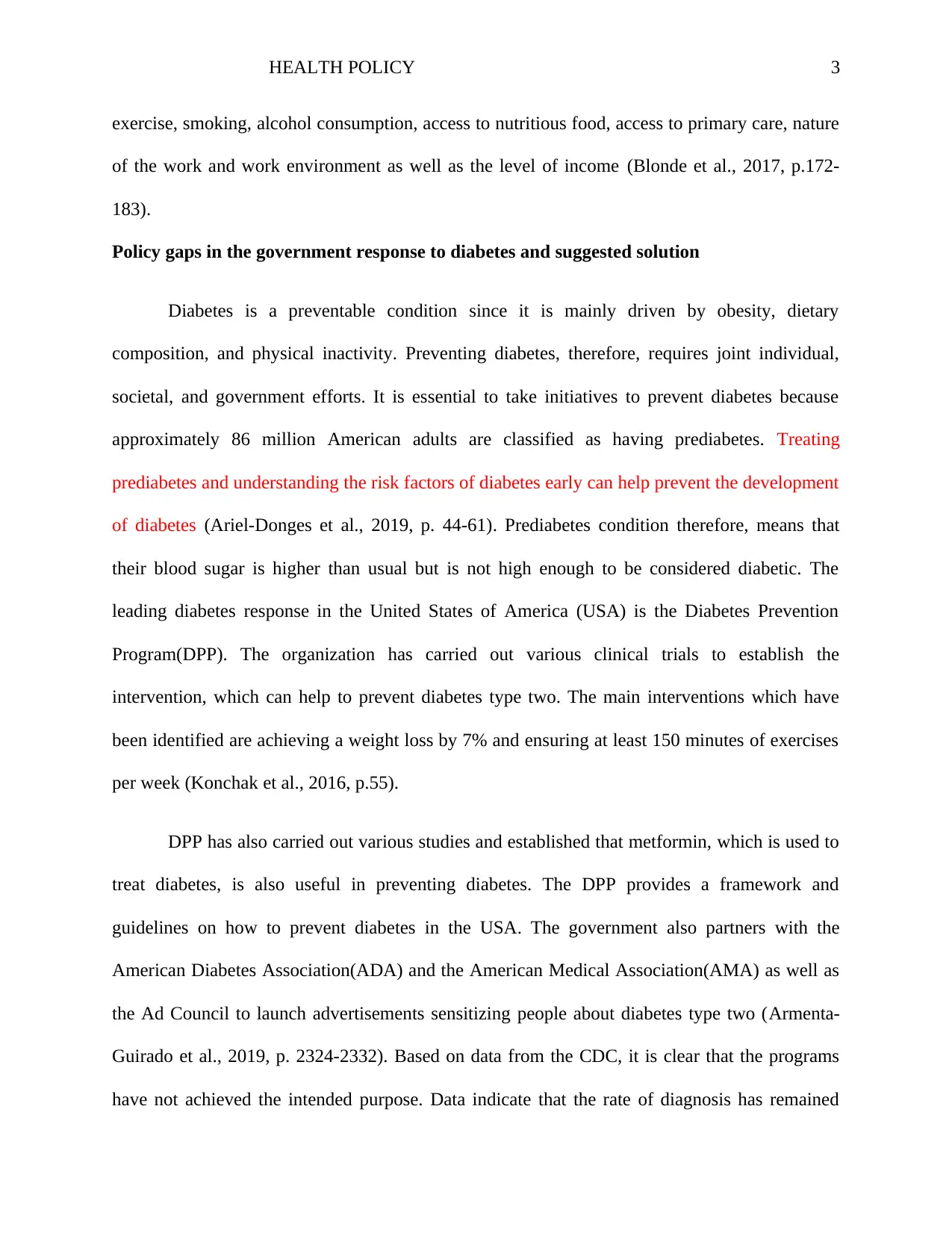
HEALTH POLICY 3
exercise, smoking, alcohol consumption, access to nutritious food, access to primary care, nature
of the work and work environment as well as the level of income (Blonde et al., 2017, p.172-
183).
Policy gaps in the government response to diabetes and suggested solution
Diabetes is a preventable condition since it is mainly driven by obesity, dietary
composition, and physical inactivity. Preventing diabetes, therefore, requires joint individual,
societal, and government efforts. It is essential to take initiatives to prevent diabetes because
approximately 86 million American adults are classified as having prediabetes. Treating
prediabetes and understanding the risk factors of diabetes early can help prevent the development
of diabetes (Ariel-Donges et al., 2019, p. 44-61). Prediabetes condition therefore, means that
their blood sugar is higher than usual but is not high enough to be considered diabetic. The
leading diabetes response in the United States of America (USA) is the Diabetes Prevention
Program(DPP). The organization has carried out various clinical trials to establish the
intervention, which can help to prevent diabetes type two. The main interventions which have
been identified are achieving a weight loss by 7% and ensuring at least 150 minutes of exercises
per week (Konchak et al., 2016, p.55).
DPP has also carried out various studies and established that metformin, which is used to
treat diabetes, is also useful in preventing diabetes. The DPP provides a framework and
guidelines on how to prevent diabetes in the USA. The government also partners with the
American Diabetes Association(ADA) and the American Medical Association(AMA) as well as
the Ad Council to launch advertisements sensitizing people about diabetes type two (Armenta-
Guirado et al., 2019, p. 2324-2332). Based on data from the CDC, it is clear that the programs
have not achieved the intended purpose. Data indicate that the rate of diagnosis has remained
exercise, smoking, alcohol consumption, access to nutritious food, access to primary care, nature
of the work and work environment as well as the level of income (Blonde et al., 2017, p.172-
183).
Policy gaps in the government response to diabetes and suggested solution
Diabetes is a preventable condition since it is mainly driven by obesity, dietary
composition, and physical inactivity. Preventing diabetes, therefore, requires joint individual,
societal, and government efforts. It is essential to take initiatives to prevent diabetes because
approximately 86 million American adults are classified as having prediabetes. Treating
prediabetes and understanding the risk factors of diabetes early can help prevent the development
of diabetes (Ariel-Donges et al., 2019, p. 44-61). Prediabetes condition therefore, means that
their blood sugar is higher than usual but is not high enough to be considered diabetic. The
leading diabetes response in the United States of America (USA) is the Diabetes Prevention
Program(DPP). The organization has carried out various clinical trials to establish the
intervention, which can help to prevent diabetes type two. The main interventions which have
been identified are achieving a weight loss by 7% and ensuring at least 150 minutes of exercises
per week (Konchak et al., 2016, p.55).
DPP has also carried out various studies and established that metformin, which is used to
treat diabetes, is also useful in preventing diabetes. The DPP provides a framework and
guidelines on how to prevent diabetes in the USA. The government also partners with the
American Diabetes Association(ADA) and the American Medical Association(AMA) as well as
the Ad Council to launch advertisements sensitizing people about diabetes type two (Armenta-
Guirado et al., 2019, p. 2324-2332). Based on data from the CDC, it is clear that the programs
have not achieved the intended purpose. Data indicate that the rate of diagnosis has remained
⊘ This is a preview!⊘
Do you want full access?
Subscribe today to unlock all pages.

Trusted by 1+ million students worldwide
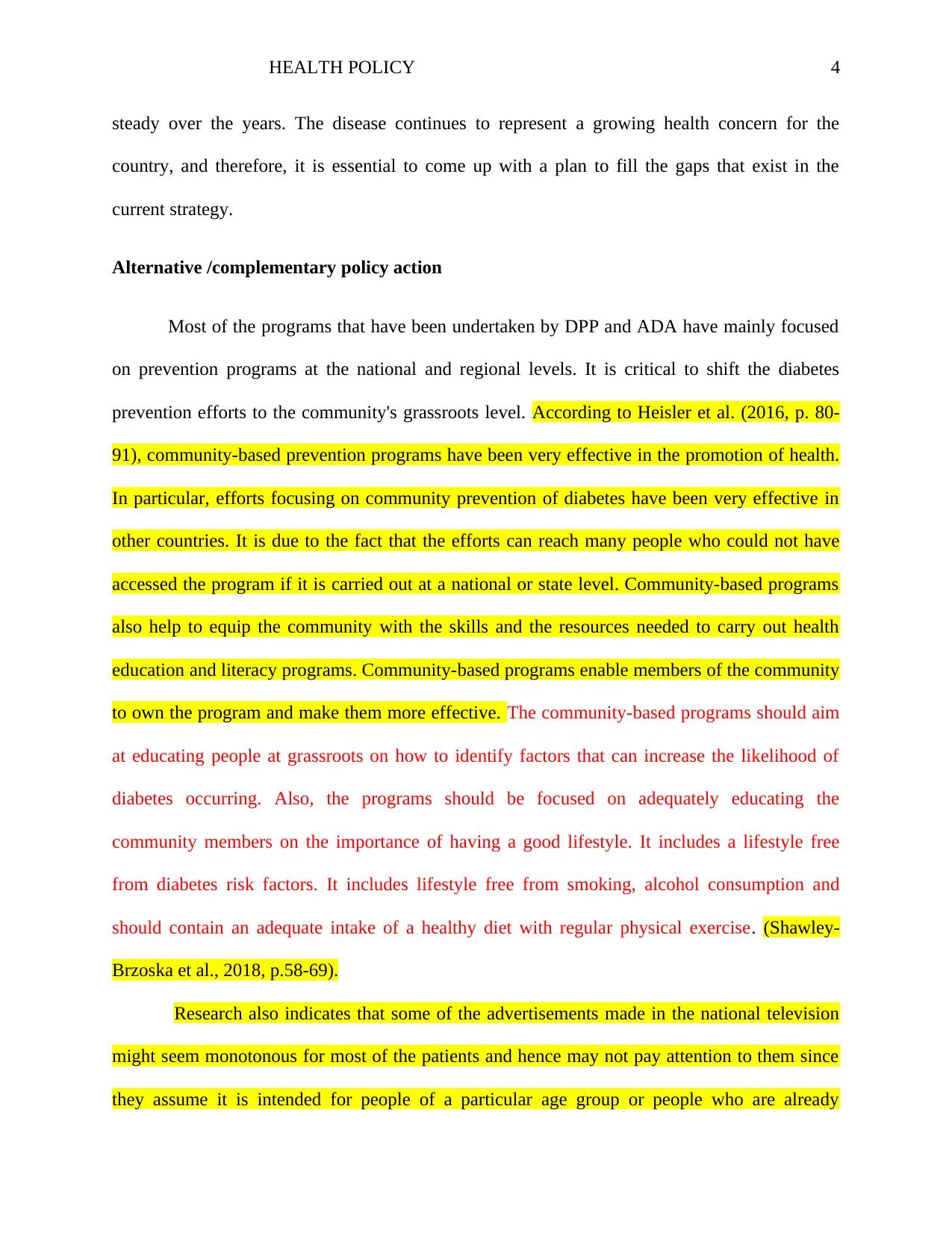
HEALTH POLICY 4
steady over the years. The disease continues to represent a growing health concern for the
country, and therefore, it is essential to come up with a plan to fill the gaps that exist in the
current strategy.
Alternative /complementary policy action
Most of the programs that have been undertaken by DPP and ADA have mainly focused
on prevention programs at the national and regional levels. It is critical to shift the diabetes
prevention efforts to the community's grassroots level. According to Heisler et al. (2016, p. 80-
91), community-based prevention programs have been very effective in the promotion of health.
In particular, efforts focusing on community prevention of diabetes have been very effective in
other countries. It is due to the fact that the efforts can reach many people who could not have
accessed the program if it is carried out at a national or state level. Community-based programs
also help to equip the community with the skills and the resources needed to carry out health
education and literacy programs. Community-based programs enable members of the community
to own the program and make them more effective. The community-based programs should aim
at educating people at grassroots on how to identify factors that can increase the likelihood of
diabetes occurring. Also, the programs should be focused on adequately educating the
community members on the importance of having a good lifestyle. It includes a lifestyle free
from diabetes risk factors. It includes lifestyle free from smoking, alcohol consumption and
should contain an adequate intake of a healthy diet with regular physical exercise. (Shawley-
Brzoska et al., 2018, p.58-69).
Research also indicates that some of the advertisements made in the national television
might seem monotonous for most of the patients and hence may not pay attention to them since
they assume it is intended for people of a particular age group or people who are already
steady over the years. The disease continues to represent a growing health concern for the
country, and therefore, it is essential to come up with a plan to fill the gaps that exist in the
current strategy.
Alternative /complementary policy action
Most of the programs that have been undertaken by DPP and ADA have mainly focused
on prevention programs at the national and regional levels. It is critical to shift the diabetes
prevention efforts to the community's grassroots level. According to Heisler et al. (2016, p. 80-
91), community-based prevention programs have been very effective in the promotion of health.
In particular, efforts focusing on community prevention of diabetes have been very effective in
other countries. It is due to the fact that the efforts can reach many people who could not have
accessed the program if it is carried out at a national or state level. Community-based programs
also help to equip the community with the skills and the resources needed to carry out health
education and literacy programs. Community-based programs enable members of the community
to own the program and make them more effective. The community-based programs should aim
at educating people at grassroots on how to identify factors that can increase the likelihood of
diabetes occurring. Also, the programs should be focused on adequately educating the
community members on the importance of having a good lifestyle. It includes a lifestyle free
from diabetes risk factors. It includes lifestyle free from smoking, alcohol consumption and
should contain an adequate intake of a healthy diet with regular physical exercise. (Shawley-
Brzoska et al., 2018, p.58-69).
Research also indicates that some of the advertisements made in the national television
might seem monotonous for most of the patients and hence may not pay attention to them since
they assume it is intended for people of a particular age group or people who are already
Paraphrase This Document
Need a fresh take? Get an instant paraphrase of this document with our AI Paraphraser
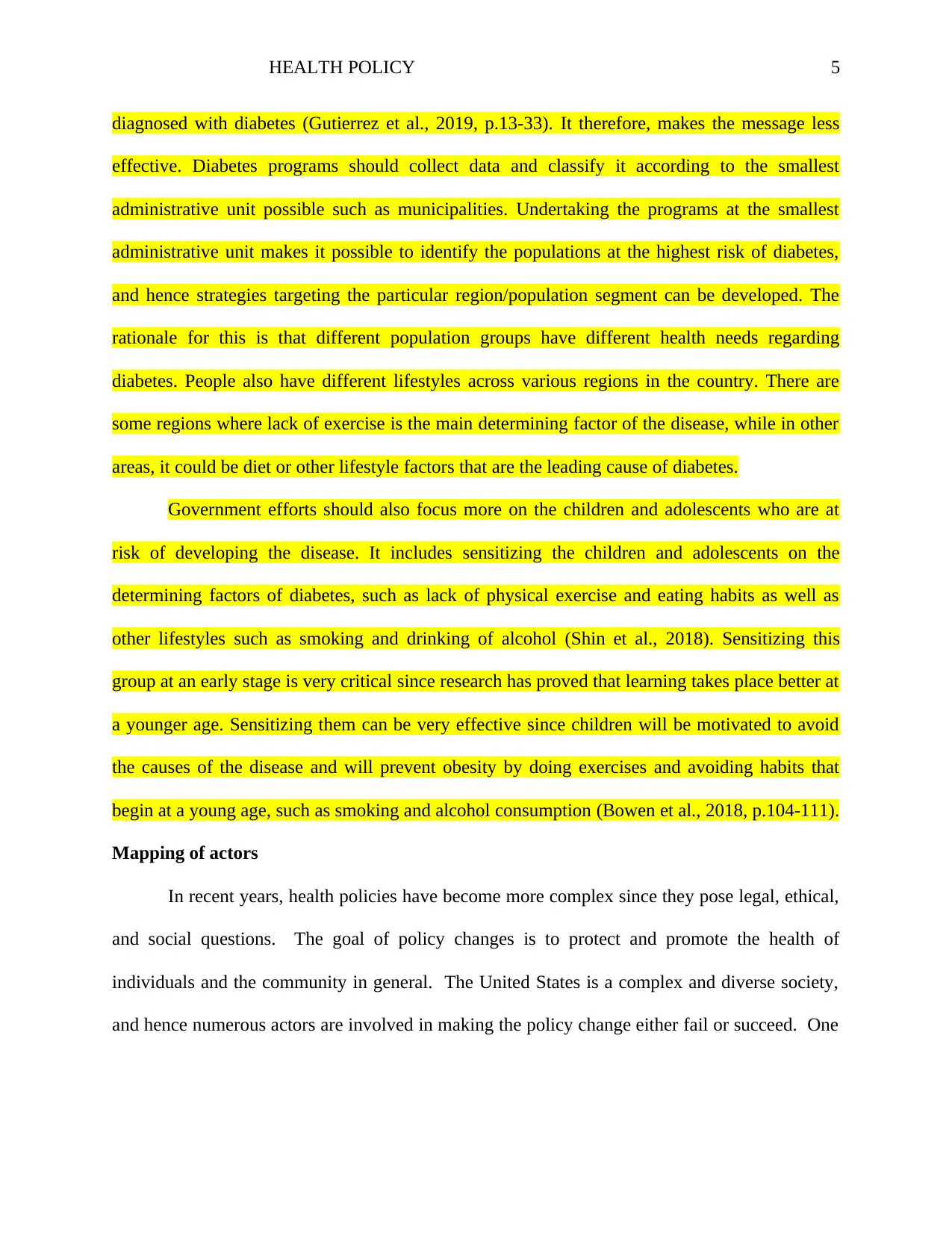
HEALTH POLICY 5
diagnosed with diabetes (Gutierrez et al., 2019, p.13-33). It therefore, makes the message less
effective. Diabetes programs should collect data and classify it according to the smallest
administrative unit possible such as municipalities. Undertaking the programs at the smallest
administrative unit makes it possible to identify the populations at the highest risk of diabetes,
and hence strategies targeting the particular region/population segment can be developed. The
rationale for this is that different population groups have different health needs regarding
diabetes. People also have different lifestyles across various regions in the country. There are
some regions where lack of exercise is the main determining factor of the disease, while in other
areas, it could be diet or other lifestyle factors that are the leading cause of diabetes.
Government efforts should also focus more on the children and adolescents who are at
risk of developing the disease. It includes sensitizing the children and adolescents on the
determining factors of diabetes, such as lack of physical exercise and eating habits as well as
other lifestyles such as smoking and drinking of alcohol (Shin et al., 2018). Sensitizing this
group at an early stage is very critical since research has proved that learning takes place better at
a younger age. Sensitizing them can be very effective since children will be motivated to avoid
the causes of the disease and will prevent obesity by doing exercises and avoiding habits that
begin at a young age, such as smoking and alcohol consumption (Bowen et al., 2018, p.104-111).
Mapping of actors
In recent years, health policies have become more complex since they pose legal, ethical,
and social questions. The goal of policy changes is to protect and promote the health of
individuals and the community in general. The United States is a complex and diverse society,
and hence numerous actors are involved in making the policy change either fail or succeed. One
diagnosed with diabetes (Gutierrez et al., 2019, p.13-33). It therefore, makes the message less
effective. Diabetes programs should collect data and classify it according to the smallest
administrative unit possible such as municipalities. Undertaking the programs at the smallest
administrative unit makes it possible to identify the populations at the highest risk of diabetes,
and hence strategies targeting the particular region/population segment can be developed. The
rationale for this is that different population groups have different health needs regarding
diabetes. People also have different lifestyles across various regions in the country. There are
some regions where lack of exercise is the main determining factor of the disease, while in other
areas, it could be diet or other lifestyle factors that are the leading cause of diabetes.
Government efforts should also focus more on the children and adolescents who are at
risk of developing the disease. It includes sensitizing the children and adolescents on the
determining factors of diabetes, such as lack of physical exercise and eating habits as well as
other lifestyles such as smoking and drinking of alcohol (Shin et al., 2018). Sensitizing this
group at an early stage is very critical since research has proved that learning takes place better at
a younger age. Sensitizing them can be very effective since children will be motivated to avoid
the causes of the disease and will prevent obesity by doing exercises and avoiding habits that
begin at a young age, such as smoking and alcohol consumption (Bowen et al., 2018, p.104-111).
Mapping of actors
In recent years, health policies have become more complex since they pose legal, ethical,
and social questions. The goal of policy changes is to protect and promote the health of
individuals and the community in general. The United States is a complex and diverse society,
and hence numerous actors are involved in making the policy change either fail or succeed. One
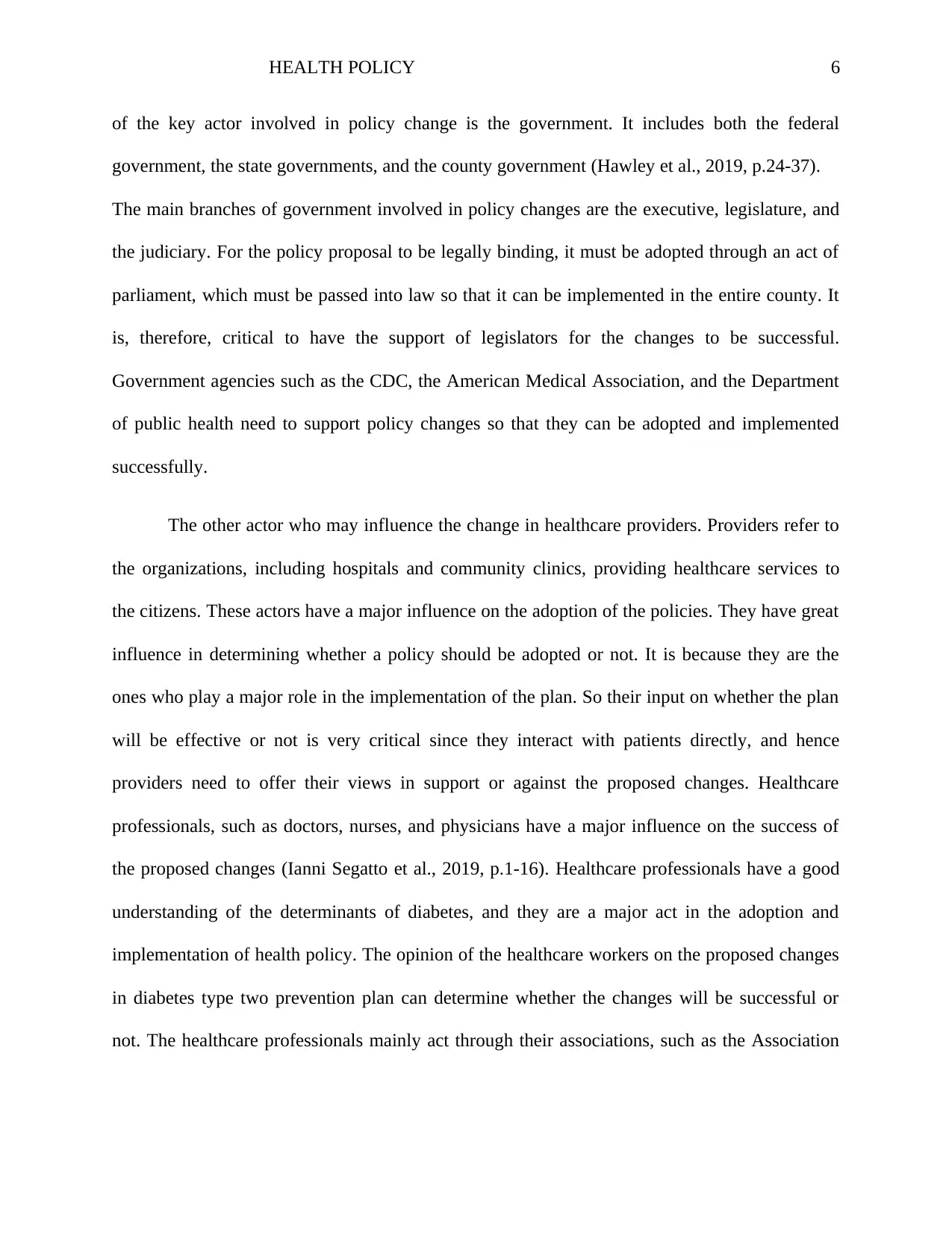
HEALTH POLICY 6
of the key actor involved in policy change is the government. It includes both the federal
government, the state governments, and the county government (Hawley et al., 2019, p.24-37).
The main branches of government involved in policy changes are the executive, legislature, and
the judiciary. For the policy proposal to be legally binding, it must be adopted through an act of
parliament, which must be passed into law so that it can be implemented in the entire county. It
is, therefore, critical to have the support of legislators for the changes to be successful.
Government agencies such as the CDC, the American Medical Association, and the Department
of public health need to support policy changes so that they can be adopted and implemented
successfully.
The other actor who may influence the change in healthcare providers. Providers refer to
the organizations, including hospitals and community clinics, providing healthcare services to
the citizens. These actors have a major influence on the adoption of the policies. They have great
influence in determining whether a policy should be adopted or not. It is because they are the
ones who play a major role in the implementation of the plan. So their input on whether the plan
will be effective or not is very critical since they interact with patients directly, and hence
providers need to offer their views in support or against the proposed changes. Healthcare
professionals, such as doctors, nurses, and physicians have a major influence on the success of
the proposed changes (Ianni Segatto et al., 2019, p.1-16). Healthcare professionals have a good
understanding of the determinants of diabetes, and they are a major act in the adoption and
implementation of health policy. The opinion of the healthcare workers on the proposed changes
in diabetes type two prevention plan can determine whether the changes will be successful or
not. The healthcare professionals mainly act through their associations, such as the Association
of the key actor involved in policy change is the government. It includes both the federal
government, the state governments, and the county government (Hawley et al., 2019, p.24-37).
The main branches of government involved in policy changes are the executive, legislature, and
the judiciary. For the policy proposal to be legally binding, it must be adopted through an act of
parliament, which must be passed into law so that it can be implemented in the entire county. It
is, therefore, critical to have the support of legislators for the changes to be successful.
Government agencies such as the CDC, the American Medical Association, and the Department
of public health need to support policy changes so that they can be adopted and implemented
successfully.
The other actor who may influence the change in healthcare providers. Providers refer to
the organizations, including hospitals and community clinics, providing healthcare services to
the citizens. These actors have a major influence on the adoption of the policies. They have great
influence in determining whether a policy should be adopted or not. It is because they are the
ones who play a major role in the implementation of the plan. So their input on whether the plan
will be effective or not is very critical since they interact with patients directly, and hence
providers need to offer their views in support or against the proposed changes. Healthcare
professionals, such as doctors, nurses, and physicians have a major influence on the success of
the proposed changes (Ianni Segatto et al., 2019, p.1-16). Healthcare professionals have a good
understanding of the determinants of diabetes, and they are a major act in the adoption and
implementation of health policy. The opinion of the healthcare workers on the proposed changes
in diabetes type two prevention plan can determine whether the changes will be successful or
not. The healthcare professionals mainly act through their associations, such as the Association
⊘ This is a preview!⊘
Do you want full access?
Subscribe today to unlock all pages.

Trusted by 1+ million students worldwide
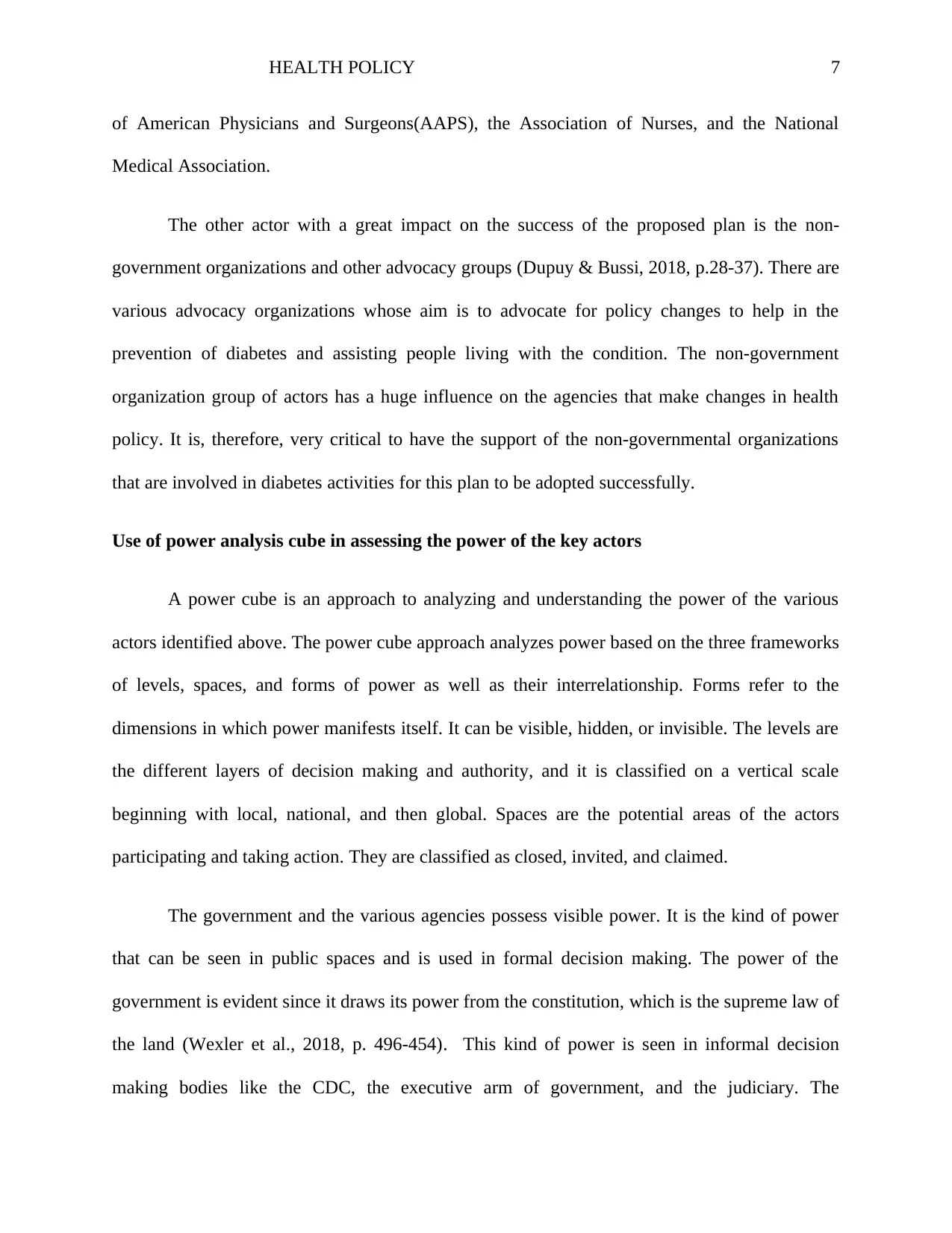
HEALTH POLICY 7
of American Physicians and Surgeons(AAPS), the Association of Nurses, and the National
Medical Association.
The other actor with a great impact on the success of the proposed plan is the non-
government organizations and other advocacy groups (Dupuy & Bussi, 2018, p.28-37). There are
various advocacy organizations whose aim is to advocate for policy changes to help in the
prevention of diabetes and assisting people living with the condition. The non-government
organization group of actors has a huge influence on the agencies that make changes in health
policy. It is, therefore, very critical to have the support of the non-governmental organizations
that are involved in diabetes activities for this plan to be adopted successfully.
Use of power analysis cube in assessing the power of the key actors
A power cube is an approach to analyzing and understanding the power of the various
actors identified above. The power cube approach analyzes power based on the three frameworks
of levels, spaces, and forms of power as well as their interrelationship. Forms refer to the
dimensions in which power manifests itself. It can be visible, hidden, or invisible. The levels are
the different layers of decision making and authority, and it is classified on a vertical scale
beginning with local, national, and then global. Spaces are the potential areas of the actors
participating and taking action. They are classified as closed, invited, and claimed.
The government and the various agencies possess visible power. It is the kind of power
that can be seen in public spaces and is used in formal decision making. The power of the
government is evident since it draws its power from the constitution, which is the supreme law of
the land (Wexler et al., 2018, p. 496-454). This kind of power is seen in informal decision
making bodies like the CDC, the executive arm of government, and the judiciary. The
of American Physicians and Surgeons(AAPS), the Association of Nurses, and the National
Medical Association.
The other actor with a great impact on the success of the proposed plan is the non-
government organizations and other advocacy groups (Dupuy & Bussi, 2018, p.28-37). There are
various advocacy organizations whose aim is to advocate for policy changes to help in the
prevention of diabetes and assisting people living with the condition. The non-government
organization group of actors has a huge influence on the agencies that make changes in health
policy. It is, therefore, very critical to have the support of the non-governmental organizations
that are involved in diabetes activities for this plan to be adopted successfully.
Use of power analysis cube in assessing the power of the key actors
A power cube is an approach to analyzing and understanding the power of the various
actors identified above. The power cube approach analyzes power based on the three frameworks
of levels, spaces, and forms of power as well as their interrelationship. Forms refer to the
dimensions in which power manifests itself. It can be visible, hidden, or invisible. The levels are
the different layers of decision making and authority, and it is classified on a vertical scale
beginning with local, national, and then global. Spaces are the potential areas of the actors
participating and taking action. They are classified as closed, invited, and claimed.
The government and the various agencies possess visible power. It is the kind of power
that can be seen in public spaces and is used in formal decision making. The power of the
government is evident since it draws its power from the constitution, which is the supreme law of
the land (Wexler et al., 2018, p. 496-454). This kind of power is seen in informal decision
making bodies like the CDC, the executive arm of government, and the judiciary. The
Paraphrase This Document
Need a fresh take? Get an instant paraphrase of this document with our AI Paraphraser
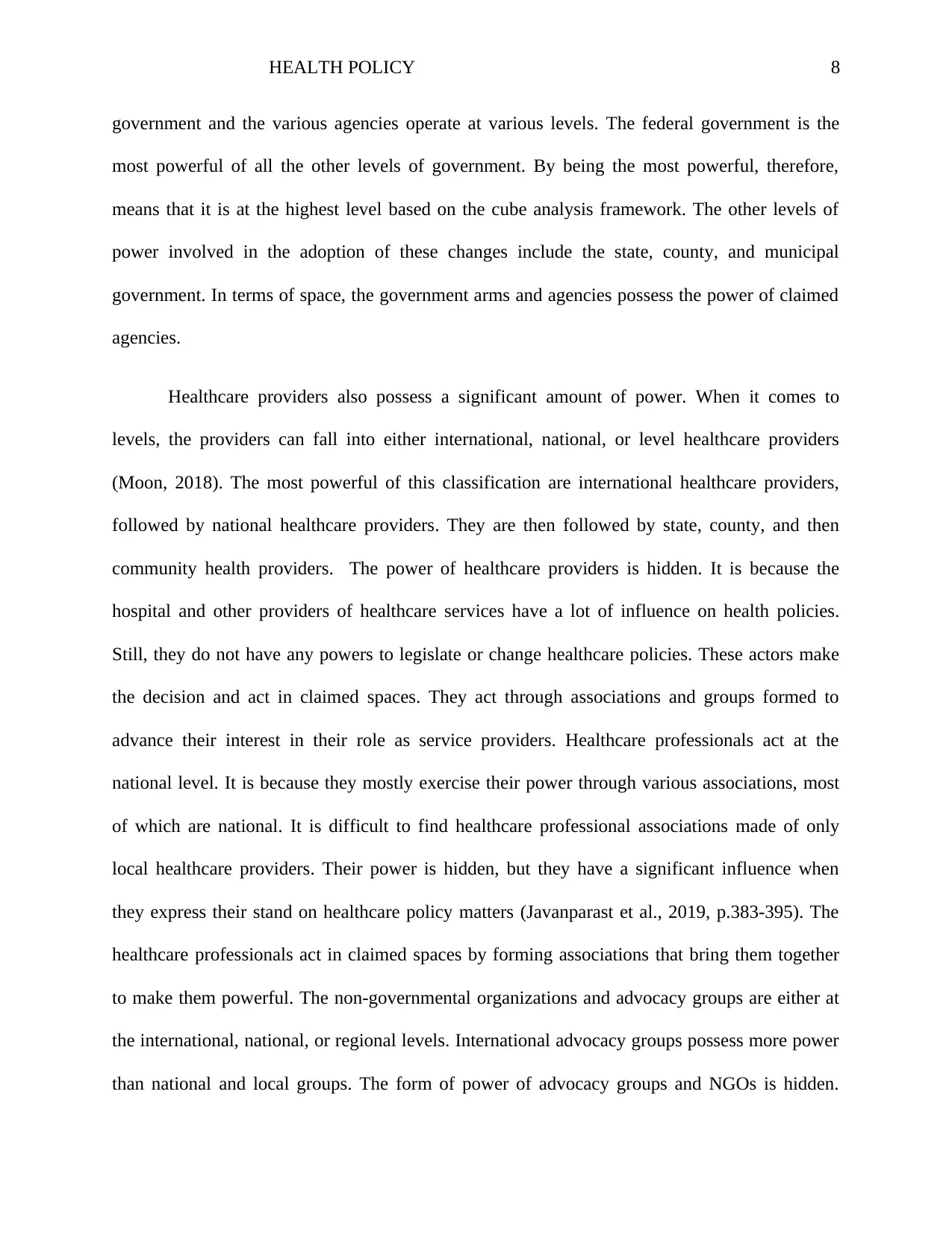
HEALTH POLICY 8
government and the various agencies operate at various levels. The federal government is the
most powerful of all the other levels of government. By being the most powerful, therefore,
means that it is at the highest level based on the cube analysis framework. The other levels of
power involved in the adoption of these changes include the state, county, and municipal
government. In terms of space, the government arms and agencies possess the power of claimed
agencies.
Healthcare providers also possess a significant amount of power. When it comes to
levels, the providers can fall into either international, national, or level healthcare providers
(Moon, 2018). The most powerful of this classification are international healthcare providers,
followed by national healthcare providers. They are then followed by state, county, and then
community health providers. The power of healthcare providers is hidden. It is because the
hospital and other providers of healthcare services have a lot of influence on health policies.
Still, they do not have any powers to legislate or change healthcare policies. These actors make
the decision and act in claimed spaces. They act through associations and groups formed to
advance their interest in their role as service providers. Healthcare professionals act at the
national level. It is because they mostly exercise their power through various associations, most
of which are national. It is difficult to find healthcare professional associations made of only
local healthcare providers. Their power is hidden, but they have a significant influence when
they express their stand on healthcare policy matters (Javanparast et al., 2019, p.383-395). The
healthcare professionals act in claimed spaces by forming associations that bring them together
to make them powerful. The non-governmental organizations and advocacy groups are either at
the international, national, or regional levels. International advocacy groups possess more power
than national and local groups. The form of power of advocacy groups and NGOs is hidden.
government and the various agencies operate at various levels. The federal government is the
most powerful of all the other levels of government. By being the most powerful, therefore,
means that it is at the highest level based on the cube analysis framework. The other levels of
power involved in the adoption of these changes include the state, county, and municipal
government. In terms of space, the government arms and agencies possess the power of claimed
agencies.
Healthcare providers also possess a significant amount of power. When it comes to
levels, the providers can fall into either international, national, or level healthcare providers
(Moon, 2018). The most powerful of this classification are international healthcare providers,
followed by national healthcare providers. They are then followed by state, county, and then
community health providers. The power of healthcare providers is hidden. It is because the
hospital and other providers of healthcare services have a lot of influence on health policies.
Still, they do not have any powers to legislate or change healthcare policies. These actors make
the decision and act in claimed spaces. They act through associations and groups formed to
advance their interest in their role as service providers. Healthcare professionals act at the
national level. It is because they mostly exercise their power through various associations, most
of which are national. It is difficult to find healthcare professional associations made of only
local healthcare providers. Their power is hidden, but they have a significant influence when
they express their stand on healthcare policy matters (Javanparast et al., 2019, p.383-395). The
healthcare professionals act in claimed spaces by forming associations that bring them together
to make them powerful. The non-governmental organizations and advocacy groups are either at
the international, national, or regional levels. International advocacy groups possess more power
than national and local groups. The form of power of advocacy groups and NGOs is hidden.
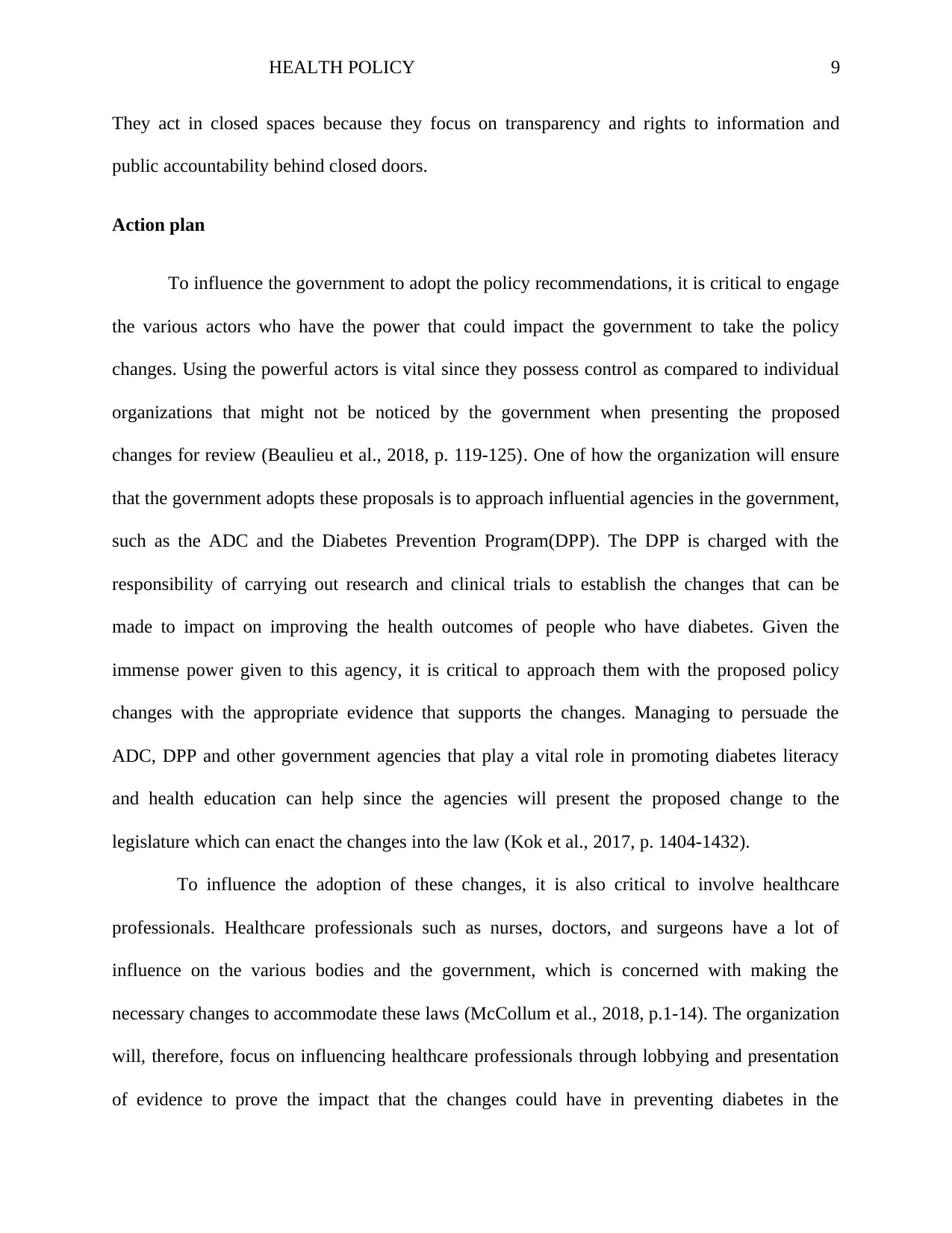
HEALTH POLICY 9
They act in closed spaces because they focus on transparency and rights to information and
public accountability behind closed doors.
Action plan
To influence the government to adopt the policy recommendations, it is critical to engage
the various actors who have the power that could impact the government to take the policy
changes. Using the powerful actors is vital since they possess control as compared to individual
organizations that might not be noticed by the government when presenting the proposed
changes for review (Beaulieu et al., 2018, p. 119-125). One of how the organization will ensure
that the government adopts these proposals is to approach influential agencies in the government,
such as the ADC and the Diabetes Prevention Program(DPP). The DPP is charged with the
responsibility of carrying out research and clinical trials to establish the changes that can be
made to impact on improving the health outcomes of people who have diabetes. Given the
immense power given to this agency, it is critical to approach them with the proposed policy
changes with the appropriate evidence that supports the changes. Managing to persuade the
ADC, DPP and other government agencies that play a vital role in promoting diabetes literacy
and health education can help since the agencies will present the proposed change to the
legislature which can enact the changes into the law (Kok et al., 2017, p. 1404-1432).
To influence the adoption of these changes, it is also critical to involve healthcare
professionals. Healthcare professionals such as nurses, doctors, and surgeons have a lot of
influence on the various bodies and the government, which is concerned with making the
necessary changes to accommodate these laws (McCollum et al., 2018, p.1-14). The organization
will, therefore, focus on influencing healthcare professionals through lobbying and presentation
of evidence to prove the impact that the changes could have in preventing diabetes in the
They act in closed spaces because they focus on transparency and rights to information and
public accountability behind closed doors.
Action plan
To influence the government to adopt the policy recommendations, it is critical to engage
the various actors who have the power that could impact the government to take the policy
changes. Using the powerful actors is vital since they possess control as compared to individual
organizations that might not be noticed by the government when presenting the proposed
changes for review (Beaulieu et al., 2018, p. 119-125). One of how the organization will ensure
that the government adopts these proposals is to approach influential agencies in the government,
such as the ADC and the Diabetes Prevention Program(DPP). The DPP is charged with the
responsibility of carrying out research and clinical trials to establish the changes that can be
made to impact on improving the health outcomes of people who have diabetes. Given the
immense power given to this agency, it is critical to approach them with the proposed policy
changes with the appropriate evidence that supports the changes. Managing to persuade the
ADC, DPP and other government agencies that play a vital role in promoting diabetes literacy
and health education can help since the agencies will present the proposed change to the
legislature which can enact the changes into the law (Kok et al., 2017, p. 1404-1432).
To influence the adoption of these changes, it is also critical to involve healthcare
professionals. Healthcare professionals such as nurses, doctors, and surgeons have a lot of
influence on the various bodies and the government, which is concerned with making the
necessary changes to accommodate these laws (McCollum et al., 2018, p.1-14). The organization
will, therefore, focus on influencing healthcare professionals through lobbying and presentation
of evidence to prove the impact that the changes could have in preventing diabetes in the
⊘ This is a preview!⊘
Do you want full access?
Subscribe today to unlock all pages.

Trusted by 1+ million students worldwide
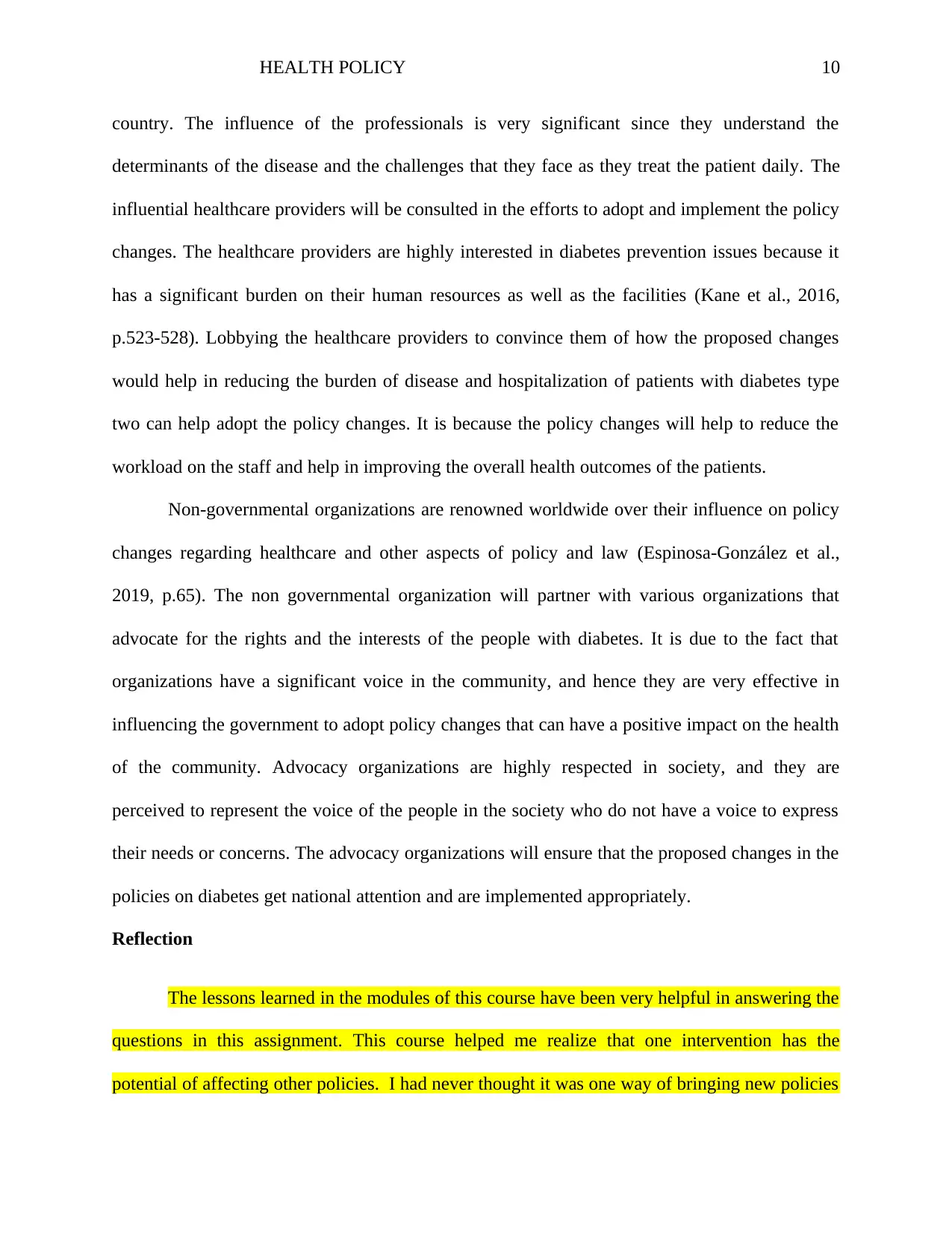
HEALTH POLICY 10
country. The influence of the professionals is very significant since they understand the
determinants of the disease and the challenges that they face as they treat the patient daily. The
influential healthcare providers will be consulted in the efforts to adopt and implement the policy
changes. The healthcare providers are highly interested in diabetes prevention issues because it
has a significant burden on their human resources as well as the facilities (Kane et al., 2016,
p.523-528). Lobbying the healthcare providers to convince them of how the proposed changes
would help in reducing the burden of disease and hospitalization of patients with diabetes type
two can help adopt the policy changes. It is because the policy changes will help to reduce the
workload on the staff and help in improving the overall health outcomes of the patients.
Non-governmental organizations are renowned worldwide over their influence on policy
changes regarding healthcare and other aspects of policy and law (Espinosa-González et al.,
2019, p.65). The non governmental organization will partner with various organizations that
advocate for the rights and the interests of the people with diabetes. It is due to the fact that
organizations have a significant voice in the community, and hence they are very effective in
influencing the government to adopt policy changes that can have a positive impact on the health
of the community. Advocacy organizations are highly respected in society, and they are
perceived to represent the voice of the people in the society who do not have a voice to express
their needs or concerns. The advocacy organizations will ensure that the proposed changes in the
policies on diabetes get national attention and are implemented appropriately.
Reflection
The lessons learned in the modules of this course have been very helpful in answering the
questions in this assignment. This course helped me realize that one intervention has the
potential of affecting other policies. I had never thought it was one way of bringing new policies
country. The influence of the professionals is very significant since they understand the
determinants of the disease and the challenges that they face as they treat the patient daily. The
influential healthcare providers will be consulted in the efforts to adopt and implement the policy
changes. The healthcare providers are highly interested in diabetes prevention issues because it
has a significant burden on their human resources as well as the facilities (Kane et al., 2016,
p.523-528). Lobbying the healthcare providers to convince them of how the proposed changes
would help in reducing the burden of disease and hospitalization of patients with diabetes type
two can help adopt the policy changes. It is because the policy changes will help to reduce the
workload on the staff and help in improving the overall health outcomes of the patients.
Non-governmental organizations are renowned worldwide over their influence on policy
changes regarding healthcare and other aspects of policy and law (Espinosa-González et al.,
2019, p.65). The non governmental organization will partner with various organizations that
advocate for the rights and the interests of the people with diabetes. It is due to the fact that
organizations have a significant voice in the community, and hence they are very effective in
influencing the government to adopt policy changes that can have a positive impact on the health
of the community. Advocacy organizations are highly respected in society, and they are
perceived to represent the voice of the people in the society who do not have a voice to express
their needs or concerns. The advocacy organizations will ensure that the proposed changes in the
policies on diabetes get national attention and are implemented appropriately.
Reflection
The lessons learned in the modules of this course have been very helpful in answering the
questions in this assignment. This course helped me realize that one intervention has the
potential of affecting other policies. I had never thought it was one way of bringing new policies
Paraphrase This Document
Need a fresh take? Get an instant paraphrase of this document with our AI Paraphraser
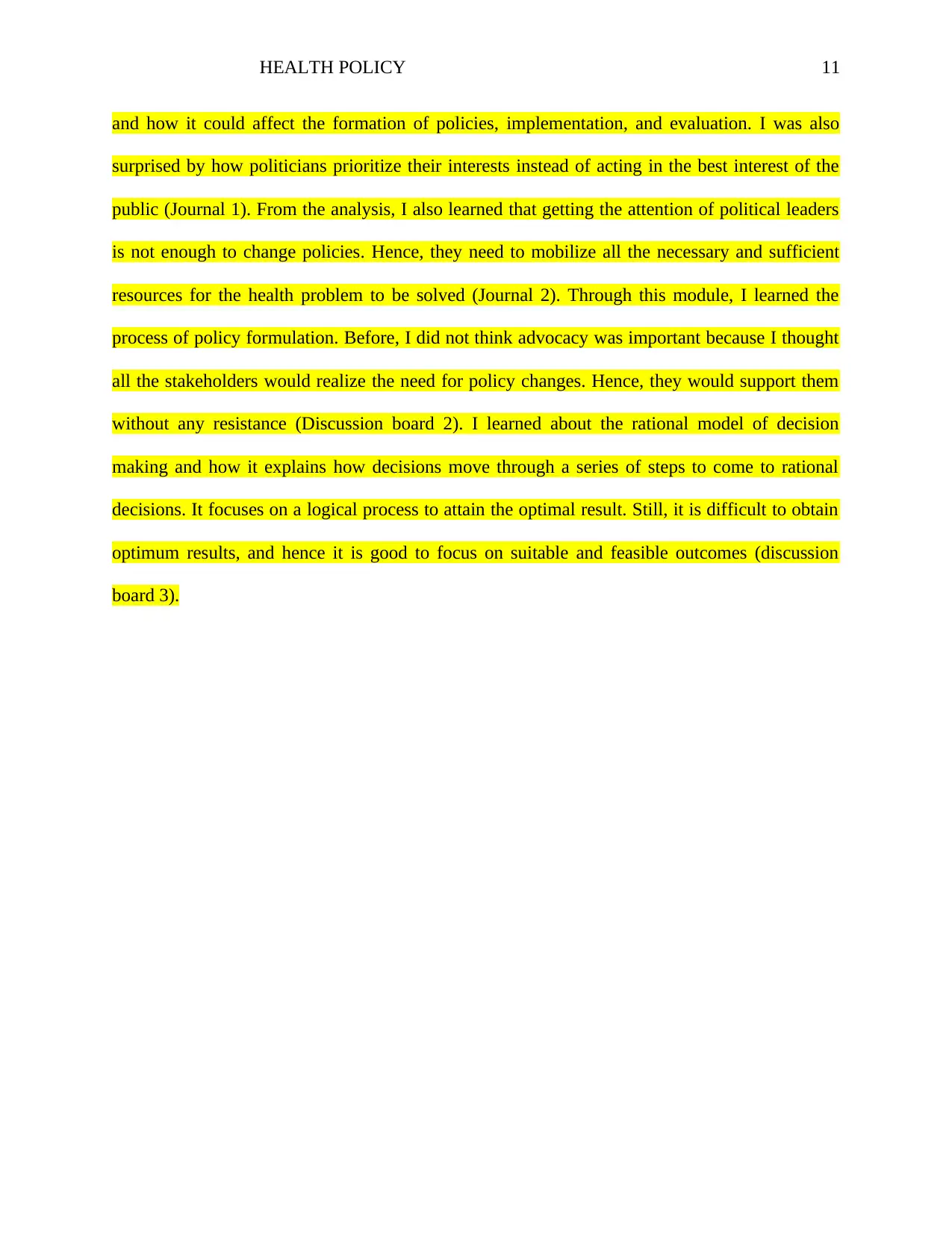
HEALTH POLICY 11
and how it could affect the formation of policies, implementation, and evaluation. I was also
surprised by how politicians prioritize their interests instead of acting in the best interest of the
public (Journal 1). From the analysis, I also learned that getting the attention of political leaders
is not enough to change policies. Hence, they need to mobilize all the necessary and sufficient
resources for the health problem to be solved (Journal 2). Through this module, I learned the
process of policy formulation. Before, I did not think advocacy was important because I thought
all the stakeholders would realize the need for policy changes. Hence, they would support them
without any resistance (Discussion board 2). I learned about the rational model of decision
making and how it explains how decisions move through a series of steps to come to rational
decisions. It focuses on a logical process to attain the optimal result. Still, it is difficult to obtain
optimum results, and hence it is good to focus on suitable and feasible outcomes (discussion
board 3).
and how it could affect the formation of policies, implementation, and evaluation. I was also
surprised by how politicians prioritize their interests instead of acting in the best interest of the
public (Journal 1). From the analysis, I also learned that getting the attention of political leaders
is not enough to change policies. Hence, they need to mobilize all the necessary and sufficient
resources for the health problem to be solved (Journal 2). Through this module, I learned the
process of policy formulation. Before, I did not think advocacy was important because I thought
all the stakeholders would realize the need for policy changes. Hence, they would support them
without any resistance (Discussion board 2). I learned about the rational model of decision
making and how it explains how decisions move through a series of steps to come to rational
decisions. It focuses on a logical process to attain the optimal result. Still, it is difficult to obtain
optimum results, and hence it is good to focus on suitable and feasible outcomes (discussion
board 3).
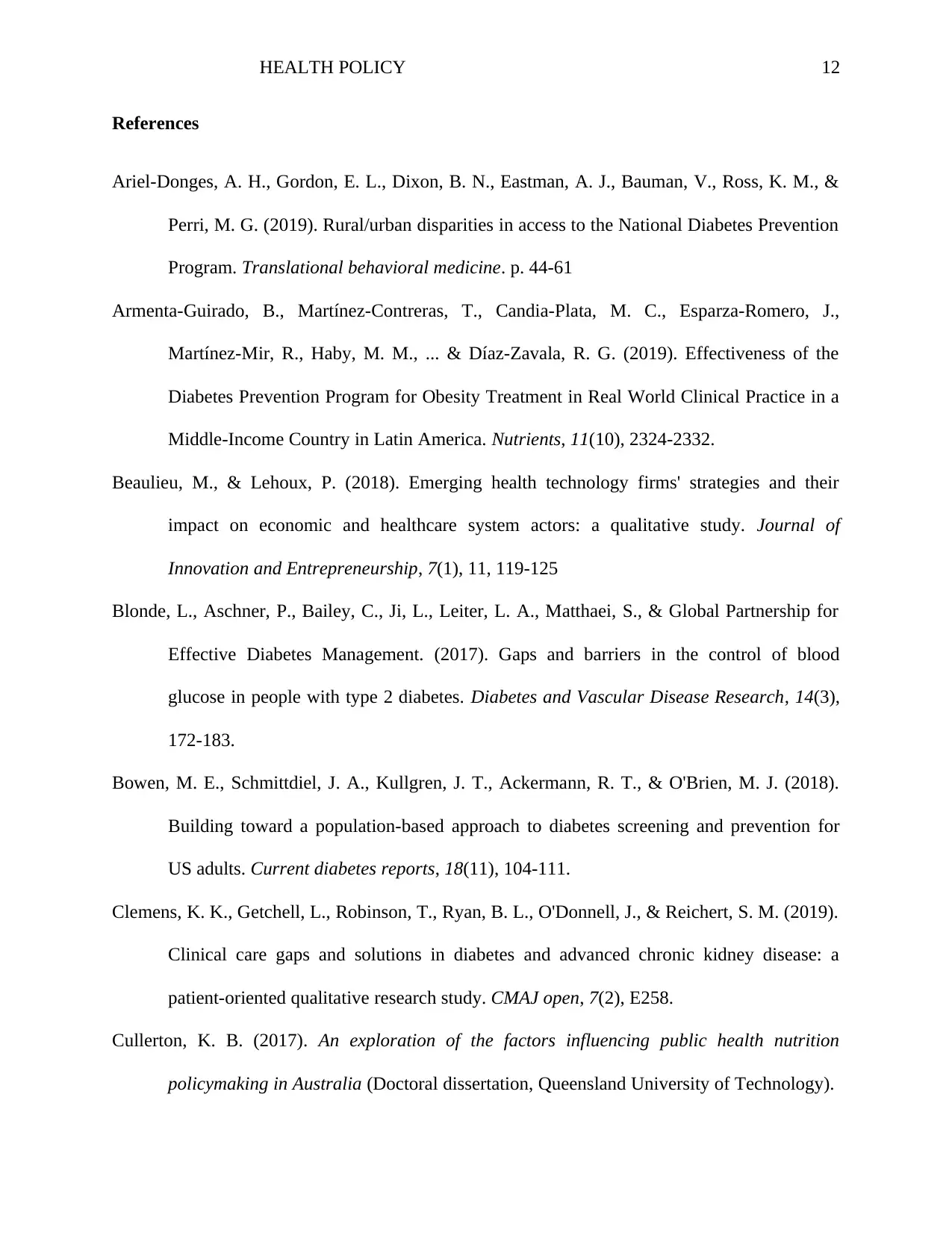
HEALTH POLICY 12
References
Ariel-Donges, A. H., Gordon, E. L., Dixon, B. N., Eastman, A. J., Bauman, V., Ross, K. M., &
Perri, M. G. (2019). Rural/urban disparities in access to the National Diabetes Prevention
Program. Translational behavioral medicine. p. 44-61
Armenta-Guirado, B., Martínez-Contreras, T., Candia-Plata, M. C., Esparza-Romero, J.,
Martínez-Mir, R., Haby, M. M., ... & Díaz-Zavala, R. G. (2019). Effectiveness of the
Diabetes Prevention Program for Obesity Treatment in Real World Clinical Practice in a
Middle-Income Country in Latin America. Nutrients, 11(10), 2324-2332.
Beaulieu, M., & Lehoux, P. (2018). Emerging health technology firms' strategies and their
impact on economic and healthcare system actors: a qualitative study. Journal of
Innovation and Entrepreneurship, 7(1), 11, 119-125
Blonde, L., Aschner, P., Bailey, C., Ji, L., Leiter, L. A., Matthaei, S., & Global Partnership for
Effective Diabetes Management. (2017). Gaps and barriers in the control of blood
glucose in people with type 2 diabetes. Diabetes and Vascular Disease Research, 14(3),
172-183.
Bowen, M. E., Schmittdiel, J. A., Kullgren, J. T., Ackermann, R. T., & O'Brien, M. J. (2018).
Building toward a population-based approach to diabetes screening and prevention for
US adults. Current diabetes reports, 18(11), 104-111.
Clemens, K. K., Getchell, L., Robinson, T., Ryan, B. L., O'Donnell, J., & Reichert, S. M. (2019).
Clinical care gaps and solutions in diabetes and advanced chronic kidney disease: a
patient-oriented qualitative research study. CMAJ open, 7(2), E258.
Cullerton, K. B. (2017). An exploration of the factors influencing public health nutrition
policymaking in Australia (Doctoral dissertation, Queensland University of Technology).
References
Ariel-Donges, A. H., Gordon, E. L., Dixon, B. N., Eastman, A. J., Bauman, V., Ross, K. M., &
Perri, M. G. (2019). Rural/urban disparities in access to the National Diabetes Prevention
Program. Translational behavioral medicine. p. 44-61
Armenta-Guirado, B., Martínez-Contreras, T., Candia-Plata, M. C., Esparza-Romero, J.,
Martínez-Mir, R., Haby, M. M., ... & Díaz-Zavala, R. G. (2019). Effectiveness of the
Diabetes Prevention Program for Obesity Treatment in Real World Clinical Practice in a
Middle-Income Country in Latin America. Nutrients, 11(10), 2324-2332.
Beaulieu, M., & Lehoux, P. (2018). Emerging health technology firms' strategies and their
impact on economic and healthcare system actors: a qualitative study. Journal of
Innovation and Entrepreneurship, 7(1), 11, 119-125
Blonde, L., Aschner, P., Bailey, C., Ji, L., Leiter, L. A., Matthaei, S., & Global Partnership for
Effective Diabetes Management. (2017). Gaps and barriers in the control of blood
glucose in people with type 2 diabetes. Diabetes and Vascular Disease Research, 14(3),
172-183.
Bowen, M. E., Schmittdiel, J. A., Kullgren, J. T., Ackermann, R. T., & O'Brien, M. J. (2018).
Building toward a population-based approach to diabetes screening and prevention for
US adults. Current diabetes reports, 18(11), 104-111.
Clemens, K. K., Getchell, L., Robinson, T., Ryan, B. L., O'Donnell, J., & Reichert, S. M. (2019).
Clinical care gaps and solutions in diabetes and advanced chronic kidney disease: a
patient-oriented qualitative research study. CMAJ open, 7(2), E258.
Cullerton, K. B. (2017). An exploration of the factors influencing public health nutrition
policymaking in Australia (Doctoral dissertation, Queensland University of Technology).
⊘ This is a preview!⊘
Do you want full access?
Subscribe today to unlock all pages.

Trusted by 1+ million students worldwide
1 out of 15
Related Documents
Your All-in-One AI-Powered Toolkit for Academic Success.
+13062052269
info@desklib.com
Available 24*7 on WhatsApp / Email
![[object Object]](/_next/static/media/star-bottom.7253800d.svg)
Unlock your academic potential
Copyright © 2020–2025 A2Z Services. All Rights Reserved. Developed and managed by ZUCOL.





